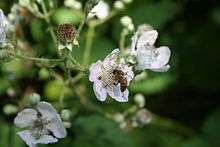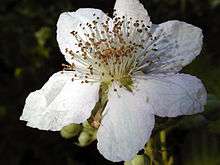Rubus armeniacus
Rubus armeniacus, the Himalayan blackberry[1] or Armenian blackberry, is a species of Rubus in the blackberry group Rubus subgenus Rubus series Discolores (P.J. Müll.) Focke. It is native to Armenia and Northern Iran, and widely naturalised elsewhere. Both its scientific name and origin have been the subject of much confusion, with much of the literature referring to it as either Rubus procerus or Rubus discolor, and often mistakenly citing its origin as western European.[2][3][4] Flora of North America, published in 2014, considers the taxonomy unsettled, and tentatively uses the older name Rubus bifrons.[5]
| Rubus armeniacus Himalayan blackberry | |
|---|---|
| Himalayan Blackberry 5 leaf example | |
 | |
| Scientific classification | |
| Kingdom: | |
| (unranked): | |
| (unranked): | |
| (unranked): | |
| Order: | |
| Family: | |
| Genus: | |
| Subgenus: | |
| Species: | R. armeniacus |
| Binomial name | |
| Rubus armeniacus Focke 1874 | |

In some areas, the plant is cultivated for its berries, but in many areas it is considered a noxious weed and an invasive species.
Description
Rubus armeniacus is a perennial plant that bears biennial stems ("canes") from the perennial root system. In its first year a new stem grows vigorously to its full length of 4–10 m, trailing along the ground or arching up to 4 m high. The stem is stout, up to 2–3 cm diameter at the base, and green. The canes can turn more red/purple if they are exposed to bright sunlight. This is common in the summer. The leaves on first year shoots are 7–20 cm long, palmately compound with either three or more commonly five leaflets. The leaflets are moderately serrated. Flowers are not produced on first year shoots. In its second year, the stem does not grow longer, but produces several side shoots, which bear smaller leaves with three leaflets (rarely a single leaflet). These leaflets are oval-acute, dark green above and pale to whitish below, with a toothed margin, and thorns along the midrib on the underside. The flowers are produced in late spring and early summer on panicles of 3–20 together on the tips of the second-year side shoots, each flower 2–2.5 cm diameter with five white or pale pink petals. The flowers are bisexual (perfect) containing both male and female reproductive structures.[6]
The fruit in botanical terminology is not a berry, but an aggregate fruit of numerous drupelets, 1.2–2 cm diameter, ripening black or dark purple. Both first and second year shoots are spiny, with short, stout, curved, sharp spines. Mature plants form a tangle of dense arching stems, the branches rooting from the node tip when they reach the ground.[7]
Cultivation
Berry crop
The species was introduced to Europe in 1835 and to Australia and North America in 1885. It was valued for its fruit, similar to that of common blackberries (Rubus fruticosus and allies) but larger and sweeter, making it a more attractive species for both domestic and commercial fruit production. The immature fruits are smaller, red, and hard with a much more sour taste. The cultivars "Himalayan Giant" and "Theodore Reimers" are particularly commonly planted.[2][3] Rubus armeniacus was used in the cultivation of the Marionberry cultivar of blackberry.[8]
Cover
When established for several years, if left alone, Rubus armeniacus can grow into a large cluster of canes. These thickets of can oftentimes provide good nesting grounds for birds, and help to provide places to rest/hide for other slightly larger mammals, such as rabbits, squirrels, beavers, etc.[9]
Invasive species
Rubus armeniacus soon escaped from cultivation and has become an invasive species in most of the temperate world.[2][3][10][8][11] Because it is so hard to contain, it quickly gets out of control, with birds and other animals eating the fruit and then spreading the seeds.[12] It is especially established West of the Cascades in the American Pacific Northwest.[9] It does well in riparian zones due to the abundance of other species in these areas, which allows it to go relatively unnoticed until it has had a chance to establish itself.[8] The shrub spreads through rhizomes underground, making it very difficult to remove. Unlike other invasive species, this plant can easily establish itself and continue to spread in ecosystems that have not experienced a disturbance.[9] Cutting the canes to the ground, or burning thickets of Rubus armeniacus are ineffective removal strategies. The best practices for removal include digging up the rhizomes and connecting underground structures, and herbicides.[8] Broken roots can resprout, making manual removal extra labor intensive, and glyphosate herbicides are largely ineffective with this plant. The most labor friendly and cost-effective way to remove this plant in smaller-scale infestations is to cut it as close to the ground as possible and then apply a drop or two of a triclopyr-based herbicide to the cut.
References
| Wikimedia Commons has media related to Rubus armeniacus. |
- "Rubus armeniacus". Natural Resources Conservation Service PLANTS Database. USDA. Retrieved 24 October 2015.
- Ceska, A. (1999). Rubus armeniacus - a correct name for Himalayan Blackberries Botanical Electronic News 230. Available online.
- Flora of NW Europe: Rubus armeniacus
- University of British Columbia Botany Photo of the Day: July 21, 2005 : Rubus armeniacus
- Lawrence A. Alice; Douglas H. Goldman; James A. Macklin & Gerry Moore (2014), "Rubus bifrons Vest, Steyermärk. Z. 3: 163. 1821", Flora of North America online, 9
- Flora of North America editorial committee (2005). Flora of North America : North of Mexico. Oxford University Press. ISBN 9780195222111. OCLC 469452032.
- Francis, J. K. (2003). Rubus discolor Weihe & Nees. pdf file
- USDA Plant Profile: Rubus armeniacus
- "Rubus armeniacus". www.fs.fed.us. Retrieved 2019-04-19.
- National list of naturalised invasive and potentially invasive garden plants (Australia) pdf file
- Max Bennett; Extension forester; Jackson County (February 2007). "Managing Himalayan Blackberry in western Oregon riparian areas" (PDF). Oregon State University. Retrieved 2014-05-26.
It escaped cultivation and has since invaded a variety of sites, including low-elevation streamside areas throughout the Pacific Northwest. Listed as a noxious weed in Oregon, Himalayan blackberry rapidly occupies disturbed areas, is very difficult to eradicate once established, and tends to out-compete native vegetation. For those trying to restore or enhance native streamside vegetation, Himalayan blackberry control is a major problem.
- The Nature Conservancy, Controlling Himalayan Blackberry in the Pacific Northwest by Jonathan Soll